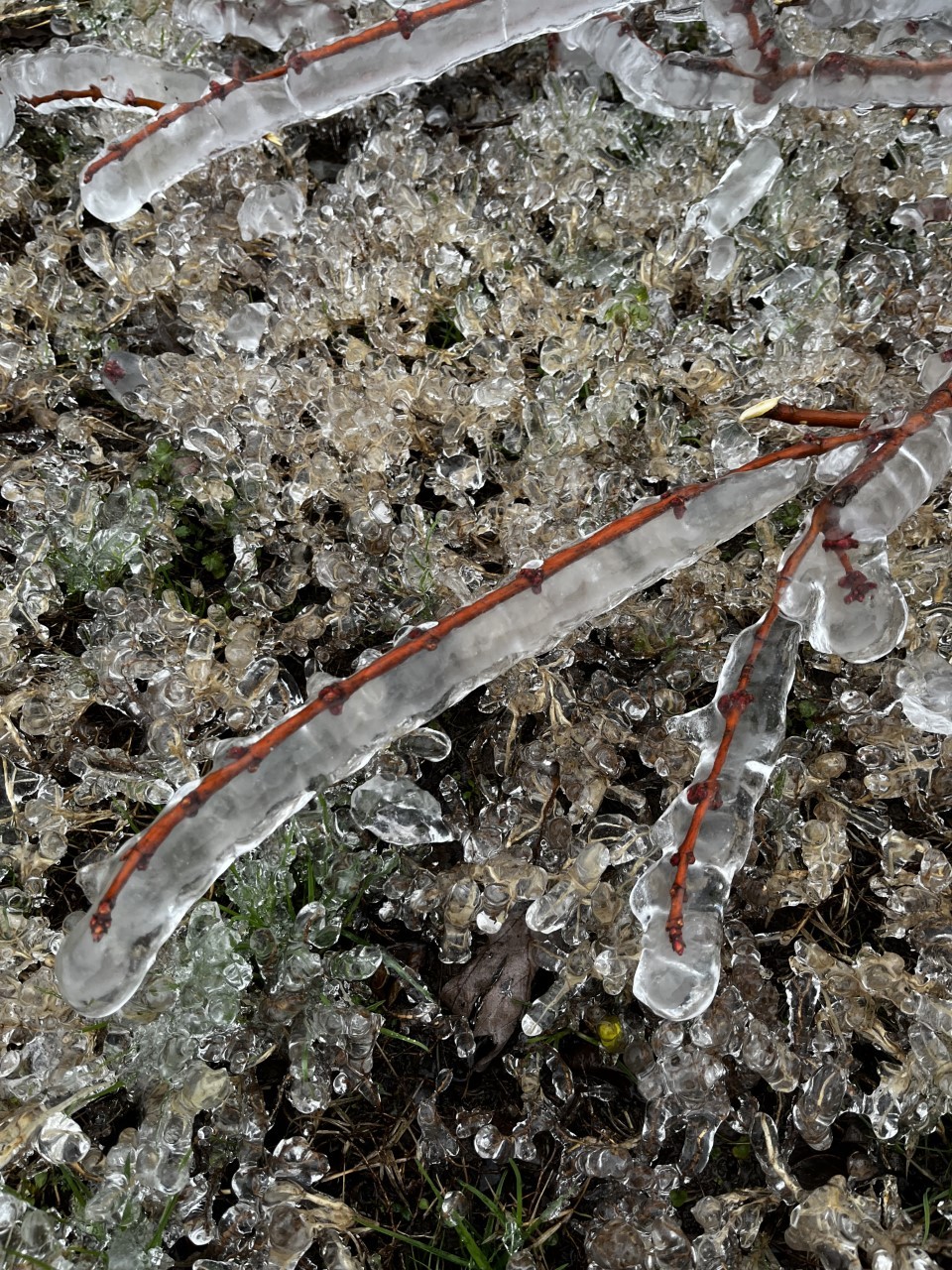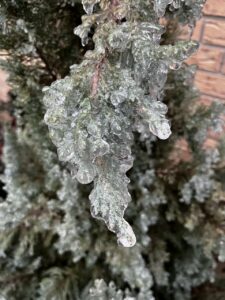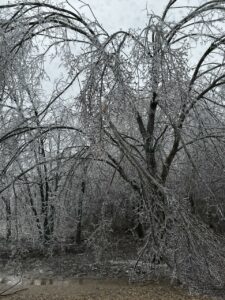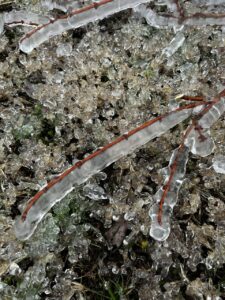Assessing Tree Damage by AgriLife’s Mario Villarino

 Homeowners assessing tree damage caused by recent storms will want to make a few important decisions soon. Small trees with minor damage can probably be taken care of by the homeowner, but large, mature trees likely will need the help of a professional tree service. It can be hard to decide whether trees with severe damage should be removed. Homeowners often are reluctant to cut down a tree, either because of sentimental attachment or because the tree provides shade or screening that won’t quickly be replaced. It can also be quite expensive to have a large tree removed. But the first priority should be safety. Assess whether the tree or some of its branches are in danger of falling now or in the near future. If the tree is not an immediate danger, you may be able to plant a new tree nearby and wait for it to grow a bit before removing the old tree. Just because a trunk is split does not necessarily mean the tree will die soon. Large, split branches or trunks that have not broken off the tree can be braced and possibly saved by an arborist. If limbs have fallen off the tree, there is nothing that can be done to save them. In either case, the wounded area in the tree will always be a weak spot that is susceptible to disease, rotting and insects. For trees that have just a few damaged limbs, it is relatively easy to remove small, lower branches with loppers or a pruning saw. Use sharp pruning tools appropriate to the size of the job to ensure a clean, smooth cut. Use hand shears on branches up to one-quarter inch in diameter, loppers on branches up to 1.5 inches in diameter and a pruning saw on branches more than 1 inch thick. Look for branches that already have broken free or been partially severed and may have left a jagged stump on the trunk. Make a cleaner cut on those branches to help facilitate the growth of natural callus tissue that with time “seals” the wound. Hire a certified arborist for larger limbs or those too far up to reach. Arborists
Homeowners assessing tree damage caused by recent storms will want to make a few important decisions soon. Small trees with minor damage can probably be taken care of by the homeowner, but large, mature trees likely will need the help of a professional tree service. It can be hard to decide whether trees with severe damage should be removed. Homeowners often are reluctant to cut down a tree, either because of sentimental attachment or because the tree provides shade or screening that won’t quickly be replaced. It can also be quite expensive to have a large tree removed. But the first priority should be safety. Assess whether the tree or some of its branches are in danger of falling now or in the near future. If the tree is not an immediate danger, you may be able to plant a new tree nearby and wait for it to grow a bit before removing the old tree. Just because a trunk is split does not necessarily mean the tree will die soon. Large, split branches or trunks that have not broken off the tree can be braced and possibly saved by an arborist. If limbs have fallen off the tree, there is nothing that can be done to save them. In either case, the wounded area in the tree will always be a weak spot that is susceptible to disease, rotting and insects. For trees that have just a few damaged limbs, it is relatively easy to remove small, lower branches with loppers or a pruning saw. Use sharp pruning tools appropriate to the size of the job to ensure a clean, smooth cut. Use hand shears on branches up to one-quarter inch in diameter, loppers on branches up to 1.5 inches in diameter and a pruning saw on branches more than 1 inch thick. Look for branches that already have broken free or been partially severed and may have left a jagged stump on the trunk. Make a cleaner cut on those branches to help facilitate the growth of natural callus tissue that with time “seals” the wound. Hire a certified arborist for larger limbs or those too far up to reach. Arborists  have the appropriate tools and equipment to safely bring down large or high limbs so that the tree, a house or other nearby objects will not be damaged. In general, pruning sealants or paint are not recommended for treating pruning wounds. There is some controversy regarding these products, but generally they have not been shown to be helpful. Additionally, there is some evidence that they interfere with the tree’s ability to form a protective callus over the wound. Following a severe storm event, not all trees will need to be pruned or removed, and many will need little or no treatment. After identifying the type of damage, risk assessment is the priority. One of the more critical tasks for the property owner is determining an acceptable level of risk. It is the responsibility of a tree owner or manager to maintain and manage their trees to protect the safety of others. This usually requires assistance from a well-qualified arborist.Post-Storm Response: Safety first! Stay clear and look for dangerous hanging limbs, broken branches and other failures before beginning cleanup or inspections. Keep others clear of the areas beneath and around damaged trees. Be alert for power lines that could be involved with damaged trees. All utility lines should be considered energized and dangerous.Damage assessment is the next step. Review the affected tree or trees to determine the level of injury. Some trees may not require any action and can recover on their own. Thechallenging part of the assessment is deciding which trees can be pruned properly to a healthy state and which trees
have the appropriate tools and equipment to safely bring down large or high limbs so that the tree, a house or other nearby objects will not be damaged. In general, pruning sealants or paint are not recommended for treating pruning wounds. There is some controversy regarding these products, but generally they have not been shown to be helpful. Additionally, there is some evidence that they interfere with the tree’s ability to form a protective callus over the wound. Following a severe storm event, not all trees will need to be pruned or removed, and many will need little or no treatment. After identifying the type of damage, risk assessment is the priority. One of the more critical tasks for the property owner is determining an acceptable level of risk. It is the responsibility of a tree owner or manager to maintain and manage their trees to protect the safety of others. This usually requires assistance from a well-qualified arborist.Post-Storm Response: Safety first! Stay clear and look for dangerous hanging limbs, broken branches and other failures before beginning cleanup or inspections. Keep others clear of the areas beneath and around damaged trees. Be alert for power lines that could be involved with damaged trees. All utility lines should be considered energized and dangerous.Damage assessment is the next step. Review the affected tree or trees to determine the level of injury. Some trees may not require any action and can recover on their own. Thechallenging part of the assessment is deciding which trees can be pruned properly to a healthy state and which trees  should be removed. Many factors are involved in the decision, anddamage may be hidden or difficult to determine. It is critical to get a professional arborist with credentials to conduct the assessment and the work required to mitigate the injured parts of the tree. Match skills with the situation when it comes to reparation of damages and restoration. Be able to recognize when tree damage requires advanced training and is best handled by the arborist. Tree work is dangerous and the hazards are compounded when storm damage is involved. Leaning trees, broken and pinned branches, as well as utility lines, can createlife-threatening situations. Basic cleanup can be helpful in the post-storm response process. Removing downed branches and limbs, and performing basic pruning on smaller, injured trees, can helpspeed recovery from the event. This also provides for a better evaluation of the site and the larger affected trees.
should be removed. Many factors are involved in the decision, anddamage may be hidden or difficult to determine. It is critical to get a professional arborist with credentials to conduct the assessment and the work required to mitigate the injured parts of the tree. Match skills with the situation when it comes to reparation of damages and restoration. Be able to recognize when tree damage requires advanced training and is best handled by the arborist. Tree work is dangerous and the hazards are compounded when storm damage is involved. Leaning trees, broken and pinned branches, as well as utility lines, can createlife-threatening situations. Basic cleanup can be helpful in the post-storm response process. Removing downed branches and limbs, and performing basic pruning on smaller, injured trees, can helpspeed recovery from the event. This also provides for a better evaluation of the site and the larger affected trees.
For more information on this or any other agricultural topic please contact the Hopkins County Extension Office at 903-885-3443 or email me at m-villarino@tamu.edu.
Contributed by Mario Villarino. Photos by Kayla Price
[adning id=”33207″]










